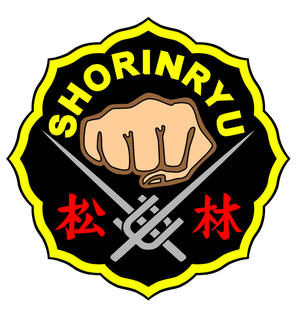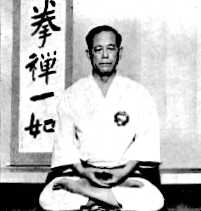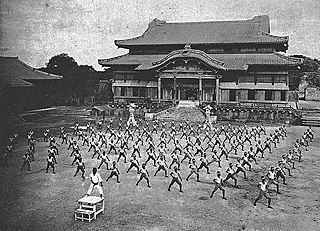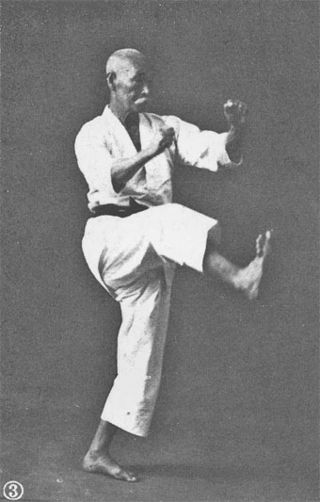
Gōjū-ryū (剛柔流), Japanese for "hard-soft style", is one of the main traditional Okinawa styles of karate, featuring a combination of hard and soft techniques. Both principles, hard and soft, come from the famous martial arts book used by Okinawan masters during the 19th and 20th centuries, the Bubishi. Gō, which means hard, refers to closed hand techniques or straight linear attacks; jū, which means soft, refers to open hand techniques and circular movements. Gōjū-ryū incorporates both circular and linear movements into its curriculum, combining hard striking attacks such as kicks and close hand punches with softer open hand circular techniques for attacking, blocking, and controlling the opponent, including joint locks, grappling, takedowns, and throws.

Shōrin-ryū (少林流) is one of the major modern Okinawan martial arts and is one of the oldest styles of karate. It was named by Choshin Chibana in 1933, but the system itself is much older. The characters 少林, meaning "sparse" or "scanty" and "forest" respectively and pronounced "shōrin" in Japanese, are also used in the Chinese and Japanese words for Shaolin. "Ryū" means "school". Shōrin-ryū combines elements of the traditional Okinawan fighting styles of Shuri-te.

Matsubayashi-Ryū (松林流), is a style of Okinawan karate founded in 1947 by Shōshin Nagamine (1907–1997). Its curriculum includes 18 kata, seven two-man yakusoku kumite routines, and kobudō (weapons) practice.
Wankan (王冠) is a kata practiced in many styles of Karate. Not much is known about the history of this kata. It originates from the Tomari-te school and in modern karate is practiced in Shorin-ryu, Shito-ryu, Shotokan, Genseiryu and Matsubayashi-ryu.

Shōshin Nagamine was an Okinawa karate master as well as a soldier, police superintendent, mayor of Naha City, play director and author.

Chōjun Miyagi was an Okinawan martial artist who founded the Gōjū-ryū school of karate by blending Okinawan and Chinese influences.

Kūsankū (クーサンクー) is one of the kata of karate and is practiced mainly in the Shuri-te lineage. It is also called Kūshankū (クーシャンクー), Kōshōkun (公相君) or Kankū (観空).
The karate kataSeisan (十三) literally means '13'. Some people refer to the kata as '13 Hands', '13 Fists', '13 Techniques', '13 Steps' or even '13 killing positions'; however, these names have no historical basis.

Chitō-ryū (千唐流) is a style of karate founded by Dr. Tsuyoshi Chitose, (1898-1984). The name of the style translates as: chi (千) - 1,000; tō (唐) - China; ryū (流) - style, school, "1,000 year old Chinese style." The character tō (唐) refers to the Tang dynasty of China. The style was officially founded in 1946.
Naihanchi (ナイハンチ) is a karate kata, performed in straddle stance. It translates to 'internal divided conflict'. The form makes use of in-fighting techniques and grappling. In Shorin-Ryu and Matsubayashi-ryū Naihanchi Shodan is the first ni kyu although it is taught to yon kyu occasionally before evaluations for the ni kyu rank. It is also the first Shorin-ryu and Shindo jinen-ryu kata to start with a technique to the right instead of the left. There are three modern kata derived from this. Some researchers believe Nidan and Sandan were created by Anko Itosu, but others believe that it was originally one kata broken into three separate parts. The fact that only Naihanchi/Tekki Shodan has a formal opening suggests the kata was split.
Shōbayashi Shōrin-ryu (少林流) is a style of Okinawan Shorin-ryu karate founded by Eizo Shimabukuro. Eizo Shimabukuro (1925-2017) dropped the Chatan Yara no Kusanku and the Oyadamari no Passai he learned from Chotoku Kyan and he added Kusanku Sho and Dai and Passai Sho and Dai of Yasutsune Itosu lineage. It is said that Eizo Shimabukuro learned these Itosu kata as well as Pinan Shodan to Godan and Naihanchin Shodan to Sandan from Choshin Chibana. However, in his book "Okinawa Karatedo Old Grandmaster Stories" Eizo Shimabukuro says that Chibana was too old to teach and so Chibana referred Shimabukuro to his senior student, Nakazato, for instruction. Eizo Shimabuku also added two kata from his time in Goju-ryu with Chojun Miyagi. These kata being Seiyunchin and Sanchin. At one time Shimabuku taught Shorin-ryu and Goju-ryu side by side.
Shorin-ryu Seibukan, also known as Sukunaihayashi, is one of the many Okinawan Shorin-ryu styles of karate.

Okinawan martial arts refers to the martial arts, such as karate, tegumi and kobudō, which originated among the indigenous people of Okinawa Island. Due to its central location, Okinawa was influenced by various cultures with a long history of trade and cultural exchange, including Japan, China and Southeast Asia, that greatly influenced the development of martial arts on Okinawa.
Ananku (安南空) is a kata from Okinawan karate. Its history in Okinawan martial arts is relatively short in comparison to other kata as it was composed by Chotoku Kyan. Its meaning is "Light from the South" or "Peace from the South", as it is thought to originate when Kyan returned from a trip to Taiwan.
The Okinawa Shōrin-ryū Karate-dō Kyudōkan Association (沖縄小林流空手道究道館連合会) is one of the seven branches of Kobayashi Shōrin-ryū style of Okinawan karate, developed by Yuchoku Higa, Hanshi 10th Dan.

Ankichi Arakaki born in 1899 in Shuri Okinawa became an Okinawan martial arts master who, despite dying at the age of 28 in 1927, is notable for aiding in the evolution of Shōrin-ryū karate. He was extremely important in the education of Shōshin Nagamine, who later went on to found Matsubayashi-ryū karate.

Chōmo Hanashiro was an Okinawan martial arts master who is notable for aiding in the evolution of Shōrin-ryū karate. Early in his childhood, he became a student of the renowned master Matsumura Sōkon, of the Shuri-te style. In addition to being a recognized expert in martial arts, Hanashiro was the first to formally use the kanji kara (空) instead of "to" or "tang" (唐), a term by which Okinawa's martial art became known: "karate".

Okinawa Karate-Dō Shōrin-ryū Kishaba Juku, also called, familiarly, Kishaba Juku, is Chokei Kishaba's private academy of the Matsubayashi-ryu style of Okinawan Karate. The Kishaba Juku was officially founded on February 1, 1998, but had been in existence as an informal karate study group since the late 1970s.

Seigi Nakamura was an Okinawan martial arts master who learned both the Shōrin-ryū and Gōjū-ryū styles of karate.
Takayoshi Nagamine was a prominent Okinawan karate master and also at times a Naha City Councilman and a Criminal Investigator for the United States Marine Corps.










